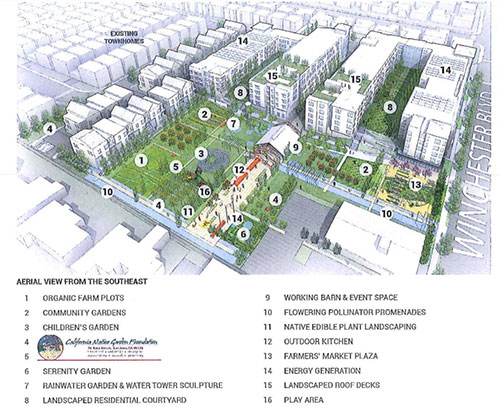
By a 5-1 vote last week, the Santa Clara City Council awarded CORE Companies an exclusive negotiating agreement (ENA) for a mixed income, multi-generational development designed around a 1.5-acre urban farm – an “agrihood” – on six acres of city-owned land at 90 N. Winchester Blvd. Council Member Pat Kolstad cast the dissenting vote, saying he had too many questions to support the motion that night.
One question that hasn’t been resolved is whether the urban farm will be privately owned or city-owned. CORE’s proposal is to keep it privately owned, but has said that negotiation was possible.
However, Kolstad congratulated agrihood supporters. “You were incredible successful in your efforts,” he said. “You have really influenced people going forward.” No matter which developer won the agreement, “You’re going to get community gardens there,” he said.
The Sept. 29 decision marks the conclusion of over 15 years of dispute about the disposition of the 17-acre former UC agricultural research station (BAREC) shut down in 2002. The City negotiated at that time to buy six acres of the property from the state for less than market value, in return for building 165 units of low-income senior housing on the property.
In 2005, 11 acres were sold to Summerhill Homes for Midtown Village, a market-rate single-family residential development of 110 houses. Construction began in 2010 and the houses went on the market in 2012, priced from $900,000 to over $1 million.
But the low-income housing stalled, leaving a 6-acre vacant lot fronting on Winchester Blvd.
In 2011, the state legislature shut down California’s redevelopment agencies – the mechanism the City used to buy the property. This spawned a county attempt to “claw back” the land, and eliminated the funding to subsidize the project. In 2013 the State Dept. of Finance ruled in favor of the City’s ownership, and last November the City Council signaled its intention to consider new development proposals with higher density, market rate housing – and even division of the parcel – in addition to the required 165 affordable apartments.
Late last year, neighborhood groups in the area west of Pruneridge began lobbying the City Council for an agrihood development, Win6Village, on the empty lot. Local business owner Kirk Vartan, who has been lobbying for an urban farm at BAREC since at least 2004, spearheaded the effort.
The RFP was published in April, and on Sept. 22 the Council reviewed three development proposals: those of The CORE Companies, ROEM Development Corporation, and USA Properties Fund (Morley Brothers LLC, Charities Housing and Santa Clara Methodist Retirement Foundation).
All of the proposals included market rate rentals, and two included for-sale units.
CORE proposed the highest density – an additional 160 market-rate apartments and 34 for-sale townhouses – and dedicated the most open space: a 1.5-acre urban farm. ROEM added 155 market-rate rentals, 10 detached single-family houses, and a 1-acre linear park. USA Properties proposed an exclusively 62-and-older development, adding 125 market-rate apartments and a 1-acre internal park. By last week’s meeting, ROEM and USA had revised their proposals, replacing the parks with urban farms.
ROEM offered the highest price for the land, $17.5 million; followed by Core at $15.5 million and USA at $10 million. USA offered the lowest rents for the affordable units, 46 percent of Area Median Income (AMI); followed by CORE at 48 percent of AMI and ROEM at 59 percent. All would make use of low income tax credit financing – developers sell these tax credits to investors in return for construction financing. These have yet to be negotiated with the State.
ROEM’s proposal required the smallest City subsidy ($6 millions) followed by CORE ($15 million), and USA ($18.2 million). This could be reduced by City land sale proceeds, RDA “boomerang” funds (the City’s portion of former RDA revenues now going to county taxing agencies), and Santa Clara County housing funds, according to the City staff agenda report. ROEM projected that its proposal would mean $7 million in additional City revenue.
This should have been a deciding factor for the Council said some. “As representatives of the City you should consider the fiduciary responsibility to the city, not yellow t-shirts,” said Chamber of Commerce President Roy Truitt, referring to the Win6Village supporters’ signature t-shirts. The $7 million contribution to the general fund could also fund new affordable housing, noted ROEM EVP Alex Sanchez.
The Council, however, was looking further out on the horizon. “The word that keeps popping into my head is opportunity and legacy,” said Council Member Dominic Caserta, prefacing his motion to award the ENA to CORE. “Youth and elderly don’t have as much opportunity to collaborate as much as they can. As Council Member Teresa O’Neill said, we need ‘shared experiences.’ This is an opportunity to do that. I’m focusing on bringing youth and elderly together, [while] being faithful to [the City commitment to] senior housing – creating a legacy.”
“CORE was creative,” said Council Member Debi Davis. CORE’s plan was “for our entire community. It met the changing needs of our community. In 10 years our community has changed drastically” and the need for affordable housing was “very high. CORE addressed the full span of community needs,” she said.
“Some of the ways those numbers [subsidies and return to the City] are different is affordability,” said O’Neill. Higher subsidies enable affordable rents for those at the lowest income levels. “We are providing subsidies for people who provide services we need in the community, so they can afford to live here.”
“This is an historic property,” said Council Member Lisa Gillmor. “It respects our past [and] it’s a wonderful new way of thinking about the future. The cost of land is going to change how we’re going to develop land. We’re going to [have to] go ‘up’ to have open space. The agrihood wasn’t a CORE concept, it was a neighborhood concept.”





